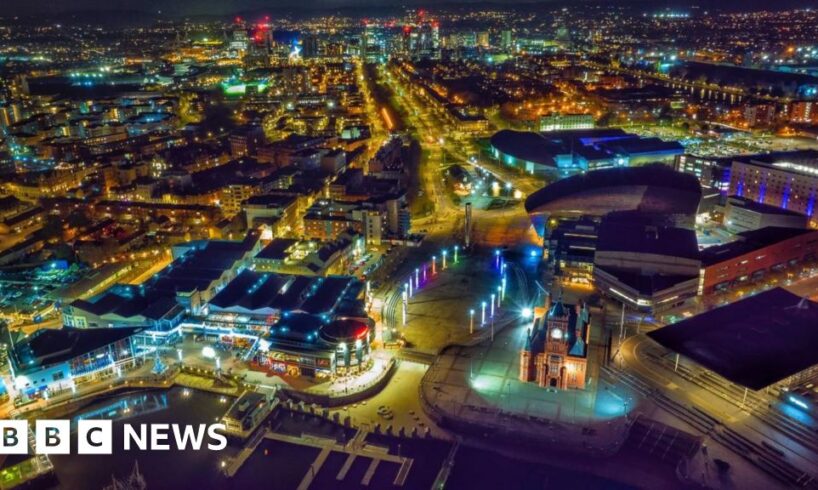
Getty Images
There could be an untapped resource under everyone’s feet in Wales’ capital that could lead to cheaper heating bills
Every home in Wales’ capital could be heated using water that lies below the city which would cut bills, pioneering research has found.
The activity of traffic, businesses, and people on Cardiff’s streets has caused what has been described as “thermal pollution”, meaning water underground is unusually warm – around 12 degrees.
This has been revealed through 234 boreholes drilled by the council in the 1990s to monitor groundwater levels during the construction of the Cardiff Bay Barrage.
Since 2014, these have been used by the British Geological Survey to measure the temperature of the water – the world’s largest survey of urban groundwater.
The results potentially have huge implications for the city’s 124,000 homes, and properties across the UK.
“I feel like I have a bit of secret knowledge,” said Ashley Patton, an engineering geologist.
“When I’m out with friends and family I’m always saying ‘there’s a borehole there’ and nobody would know it.”
On an unassuming street in Cardiff, Ms Patton is lifting what looks like an ordinary drain cover in the road.
She pulls a cable out of the hole, plugs it into her laptop, and begins taking measurements.
These readings have been taken across the city every half an hour for the past 11 years.
While most people have no idea the boreholes are even there, they are revealing a potentially transformative heat source under our feet – geothermal energy.
This is a type of renewable energy that uses the Earth’s natural heat to heat homes and businesses or generate electricity.
The data suggests the entire city could be heated using ground source heat pumps to tap into this.
Ashley Patton measures the groundwater temperature from one of 234 boreholes around Cardiff – they hide secret work few have known about up until now
“We think that we are one of the largest geo-observatories of its kind in the world,” Ms Patton added.
The British Geological Survey is the oldest of its kind globally, and has called its work in Cardiff the world’s largest survey of urban groundwater.
Ground source heat pumps are one of several solutions the UK government is looking at to meet its target of making all new homes built from this year “zero carbon-ready”.
Last year, the Welsh government said heat pumps will need to be installed in the vast majority of Welsh homes to meet climate targets.
However, it admitted in its heat strategy that the switch would be “beyond the means” of many.
What are heat pumps?
A ground source heat pump takes water from underground pipes and uses a compressor to increase the temperature
An easy way to think about how a heat pump functions is to imagine it as a fridge in reverse.
For ground source heat pumps, water is circulated underground in pipes and heated slightly by the groundwater around it.
This water is then passed through a refrigerant liquid, similar to what you would find in the back of a home fridge freezer.
The refrigerant evaporates and goes through a compressor which raises its temperature further.
This heats water in another pipe, which can then be used for hot showers, radiators or underfloor heating.
The relative stability of ground water temperatures means that ground source heat pumps can be more efficient than air source heat pumps – which transfer heat from the outside air to the water in a central heating system.
But they are not as widely used because of the high cost of installing the underground infrastructure.
A new development in Rhondda Cynon Taf could become a model for how that cost barrier could be overcome.
Parc Eirin is a development of more than 200 low carbon homes on the outskirts of Tonyrefail which is pioneering a new way of funding the infrastructure needed for ground source heating.
Rather than paying to dig boreholes and install underground pipes themselves, residents pay a standing charge to connect to the existing system, which is paid for upfront by investors, such as through pension funds.
Getty Images
Could the activity of the people on the streets of Cardiff one day help to heat the city?
“The issue we often find in Wales is that we can struggle to make these schemes commercially viable,” said Tirion Homes chief executive David Ward.
“Up until now, it’s tended to be smaller, higher end developments that would be able to afford to use ground source heating.”
Craig Williams didn’t know anything about ground source heating before buying his home
The company behind the new funding model is Kensa, which also provides the heat pumps inside the homes.
Commercial director Wouter Thijssen believes the development in Tonyrefail is a world first.
“The cost of decarbonisation doesn’t fall on the taxpayer here,” he said.
“It falls on private capital that’s crowded in, which is what we need if we’re going to achieve the targets that we have.”
The aim of the scheme, according to Mr Thijssen, is to make the transition away from gas boilers as simple as possible by emulating how utility companies work.
“Just like when you get a gas boiler, you don’t pay for additional gas pipes in your street,” he said.
Police constable Craig Williams, 30, has been living with a ground source heat pump since buying his home at Parc Eirin three years ago.
While he admits there were “teething issues”, such as there being no valve to get pressure back up when it drops as there is on a traditional boiler, he now believes every home should have one.
In 2022, the year he moved into his low carbon home, many households in the UK were struggling with high energy costs driven by post-pandemic demand and the war in Ukraine.
But Mr Williams found himself getting money back from his energy provider.
“I had a cheque from them for about £400. I don’t think that happens in many households these days,” he said.
“Everything was on the rise, and I was pretty much saving money.”
Back in Cardiff, Ashley Patton is hopeful that ground source heating could become commonplace sooner than many people realise, and Wales can lead the way.
“I think as Wales was once in charge of the Industrial Revolution through its coal, we could be leading a green revolution through geothermal energy.”
The Welsh government said its heat strategy sets out its ambition for decarbonising home and business heating systems by 2050, adding there was “strong evidence to support electrification as the main solution with ground source heat pumps likely to play a smaller role”.





